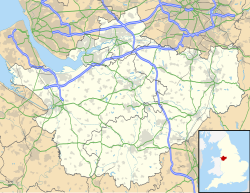Cuckooland Museum
 | |
| Established | 1990 |
|---|---|
| Location | The Old School, Chester Road, Tabley (Knutsford), WA16 0HL, England, UK |
| Coordinates | 53°17′41″N 2°25′25″W / 53.2947°N 2.4237°W |
| Type | Horological museum |
| Collection size | Over 700 cuckoo clocks |
| Director | Roman Piekarski |
| Website | www.cuckoolandmuseum.com [dead link] |
The Cuckooland Museum, previously known as the Cuckoo Clock Museum, was a museum that exhibited mainly cuckoo clocks, located in Tabley, Cheshire, England. The collection comprised 300 years of cuckoo clock-making history, since the earliest examples made in the 18th to the 21st century.
This private museum closed in 2024 and the collection is being moved to the Irish Museum of Time.[1]
Foundation
[edit]The museum was set up in 1990 by brothers Roman and Maz Piekarski after bringing together a collection of antique Black Forest cuckoo clocks that was continuously increased until the museum's last years. Both men were trained as clockmakers in Manchester from the age of 15, which is when their fascination with these timepieces began.
It became apparent to them that an important part of European clock-making history was liable to disappear if surviving examples fell into irretrievable disrepair.[2] Their guiding principles were to purchase objects of museum quality which held an important significance in the historical development of cuckoo timekeeping.
In Roman Piekarski's own words: When we started collecting in the 1970s no one wanted them because battery and electric clocks were all the rage. We picked many up for next to nothing.[3]
The collection
[edit]
In the past, the exhibition also included other kind of timepieces such as longcase, wall and bracket clocks but later on it focused mainly on cuckoo clocks.[4]
The museum also hosted a range of Black Forest cuckoo and quail clocks, trumpeter clocks, monks playing bells and other associated musical movements.
Cuckooland came to have over 700 cuckoo clocks of different styles, sizes, manufacturers and times. Many of the pieces were rare and the collection contained some of the best examples of the cuckoo clockmaker’s art:
- A "cuckoo and echo" clock that emulates the whistles and bellows the bird makes in the wild and is thought to be one of only six in the world.[5]
- The museum also displayed many timepieces made by Johann Baptist Beha, one of the most reputed Black Forest clockmaker of all times.
- Examples in Art Nouveau, Arts and Crafts and other unusual styles.
- Other rarities included; picture frame cuckoo clocks, several timepieces with a life size automaton cuckoo bird on top of the case, models combined with paintings of people or animals with blinking or flirty eyes, designer cuckoo clocks, etc.
Research and conservation
[edit]
Throughout the years, the attendance of the two brothers at clock fairs and auctions, the purchasing of specialized bibliography, trips, the internet, their own research, etc., led them to acquire many of the clocks.
One of the aims of the museum was to acquire, restore and preserve the clocks to be enjoyed by the future generations, as well as to contribute to the appreciation of the cuckoo clock in the history of horology.
See also
[edit]- Similar museums
- Deutsches Uhrenmuseum
- Dorf- und Uhrenmuseum Gütenbach
- Museum fũr Uhren und Mechanische Musik
- Schwarzwaldmuseum
References
[edit]- ^ Irish Museum of Time to add exciting new extension, Waterford News, 30 May 2024
- ^ Cuckoo Land saved in nick of time, Manchester Evening News, 9 January 2006.
- ^ Richard Webber, Meet Britain's most obsessive collectors, Daily Express, 6 April 2015
- ^ Thefreelibrary.com. It's the time to go cuckoo
- ^ Summer drives clock man cuckoo, BBC News, 28 March 2002.
